Ford Focus 2012: SYNC With MyFord Touch (Review)
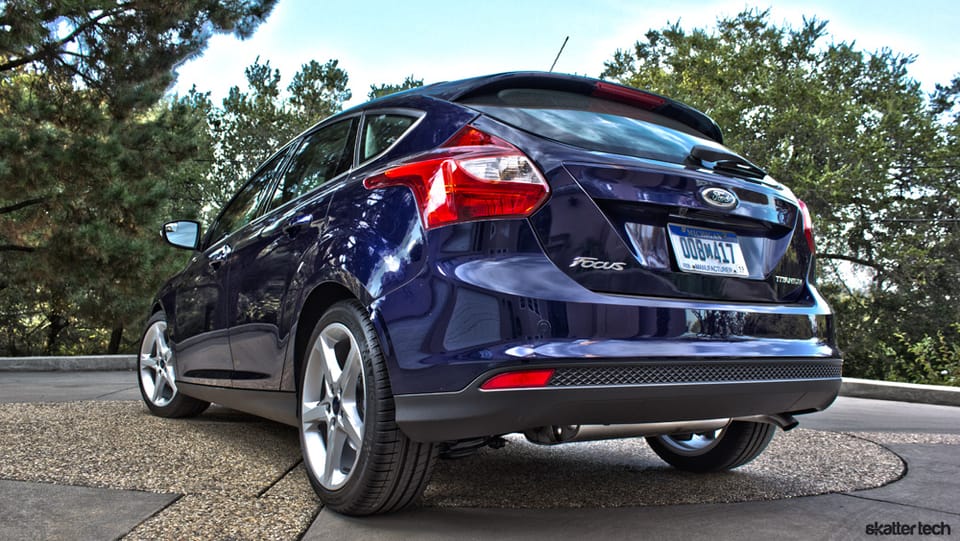
About a week ago, our friends at Ford lent Skatter Tech a brand new 5-door Focus 2012 Hatchback Titanium for an opportunity to check out the latest in-car tech. For those not familiar, the Microsoft-powered SYNC platform first made a debut at the 2007 Detroit Auto Show. Ford has since built on this platform introducing MyFord Touch at the 2010 Consumer Electronics Show for a touch-screen experience with powerful voice commands, better smart phone integration, more entertainment options, internet connectivity, navigation with traffic alerts, and many other perks.
SYNC with MyFord Touch
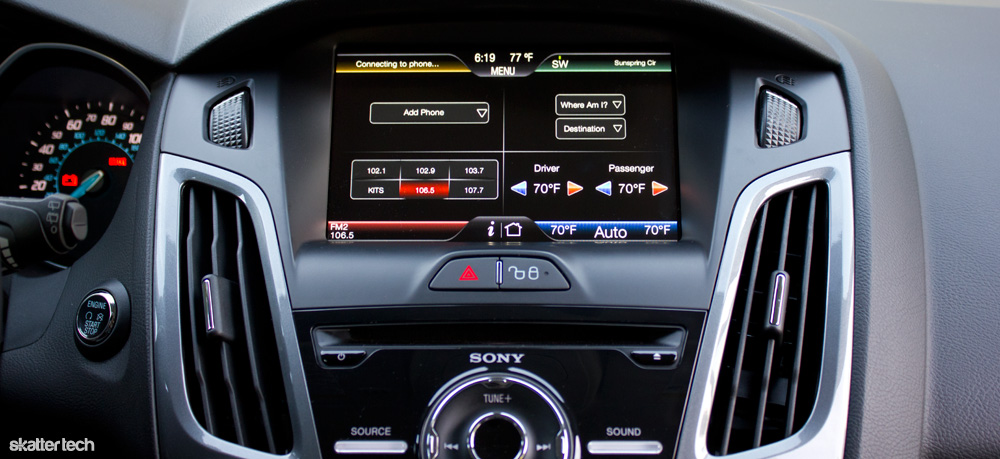
The in-car infotainment system on the Focus 2012 revolves around an 8-inch touch screen. MyFord Touch splits the home screen into four quadrants for the phone, navigation, climate, and entertainment. Common functions for any of the respective zones are accessible on the main screen and users can click on one of the color-coded region to open the full zone for more options.
Unfortunately, there is one major problem. Consumers now have high expectations when it comes to easy-to-use uncluttered and responsive interfaces thanks to the advent of the latest generation smart phones and tablets. Ford still has a long way to go when it comes to improving on its touch screen experience. The software often takes a few seconds to respond to a touch or even bring up a new menu. Interface elements are not always consistent, some fonts are quite difficult to read, and the recessed display forces drivers to lean over to see information on the edges of the screen.
Multimedia
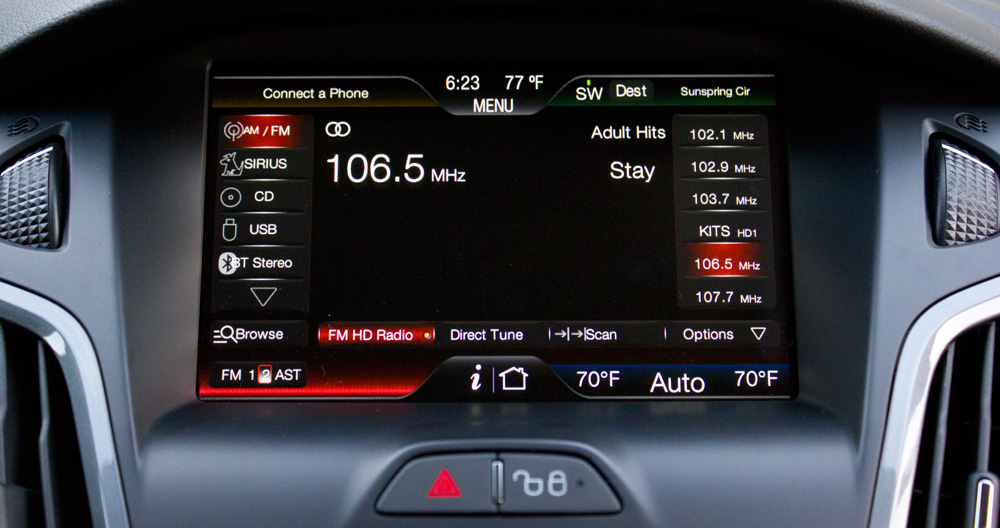
Setting aside my concerns regarding the experience of the underlying SYNC platform, the Focus 2012 actually excels when it comes to providing a robust in-car entertainment experience. Getting basics out-of-the-way, Ford includes AM/FM radio and a single-disc CD player. To take things up a notch, the Titanium model comes with a Sony 10-speaker sound system and a sub-woofer which makes HD Radio and Sirius XM a lot more enjoyable. Though I prefer the Mark Levinson sound system found in Lexus vehicles or Harman Kardon in Mercedes, those are not exactly a fair comparison.
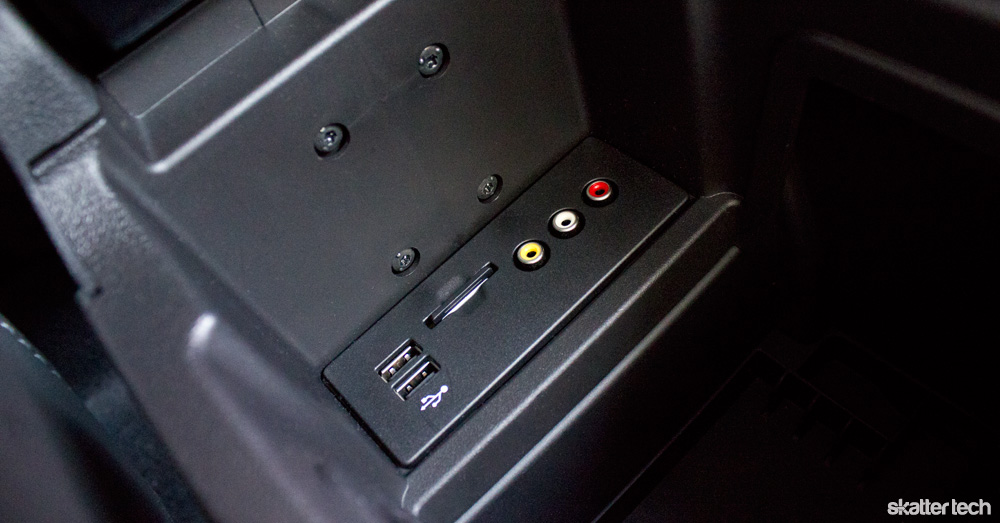
Under the center armrest are two USB ports for smart phones and MP3 players. SYNC can even access music on a flash drive or a portable hard drive. Being able to charge USB devices without a third-party car adapter with these ports is also a plus. Thanks to Bluetooth A2DP support, I could stream music from the cloud-powered Google Music straight to the car wirelessly through a Samsung Galaxy S II. I briefly tried playing tracks from both the iPod app and Rdio on an Apple iPhone 4 over Bluetooth and it worked seamlessly. I was quite impressed to find the previous and next track controls on the wheel functioning perfectly when navigating through tracks on both Android and iOS devices.
SYNC with MyFord Touch can actually display album art along with music from devices such as iPod when plugged into a USB port too. Images unfortunately did not appear when streaming tracks over Bluetooth. Also under the center armrest are RCA jacks for playing video on-screen. Plugging in a portable DVD player or a gaming console should work just fine. I was a bit disappointed to notice the lack of a dedicated AUX port, but working around the issue with a AUX-to-RCA cable is quite easy. There is a SD card reader under the arm rest for multimedia as well, though a card with navigation data occupies the slot for those who bought the respective technology package.
Navigation System
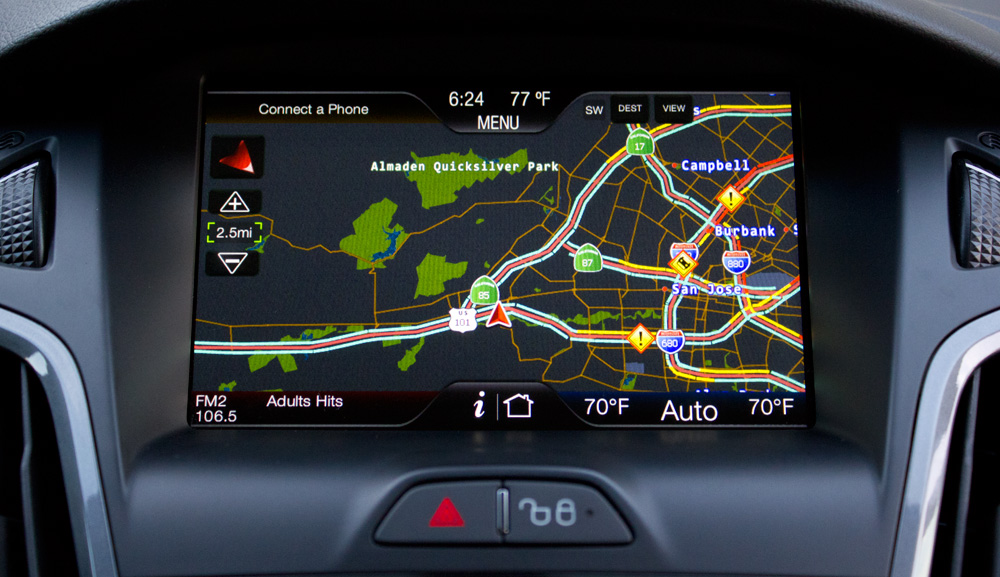
While portable navigation systems now retail for under $100, many drivers still prefer a factory out-of-the-box solution. Those who opt for the SYNC with Navigation package can enjoy the convenience of voice-guided turn-by-turn directions with traffic alerts powered by TeleNav. The touch screen interface lets drivers select a home location, configure favorites, browse previous destinations, search for points of interest, input a street address, find an intersection, or look for places on a map.
I tested the reliability of the navigator over a period of a week while driving across the San Francisco Bay Area. While the directions were spot-on the vast majority of the time, the navigator sent me driving in circles in at least two occasions even though I was just a few blocks away from the final destination. Re-calculating a route also took a little longer than a 2012 car should take. Bring up memories of the sluggishness of the Garmin StreetPilot I purchased nearly a decade ago is never a good sign. I still felt Google Maps Navigation works better on my Android smart phone.
Voice commands are another highly touted feature. SYNC with MyFord Touch, powered by Nuance, adds recognition support for over 10,000 words. After putting this to the test while on the road, I found plenty of good and some bad. Starting with the positive aspects, the voice recognition was actually quite accurate. The navigator quickly pulled up a list of possible matches within seconds when I tried dictating several addresses and names of restaurants.
With that being said, the system frustratingly requires speaking very specific phrases which may take sometime to learn. However, that was actually not the real problem. The entire reason for voice activated car technology is to keep drivers focused on the road. Unfortunately, SYNC with MyFord Touch fails to alleviate that issue. Well-designed voice integration should only require one or two interactions to input a destination. With the current system, I found myself having to interact nearly 4-5 times before the navigator begins guidance in almost every occasion.
I also felt the maps screen could use a better color palette for distinguishing labels from streets and highways. The display was also overly cluttered with way too much overlaid information. Keying in an address was incredibly slow since the system takes a second or two to catch up with itself after a pressing a digit or letter. While I do not expect the quality of the Google Earth implementation on an Audi which even has satellite imagery, snappier performance could go a long way.
Smart Phone Integration
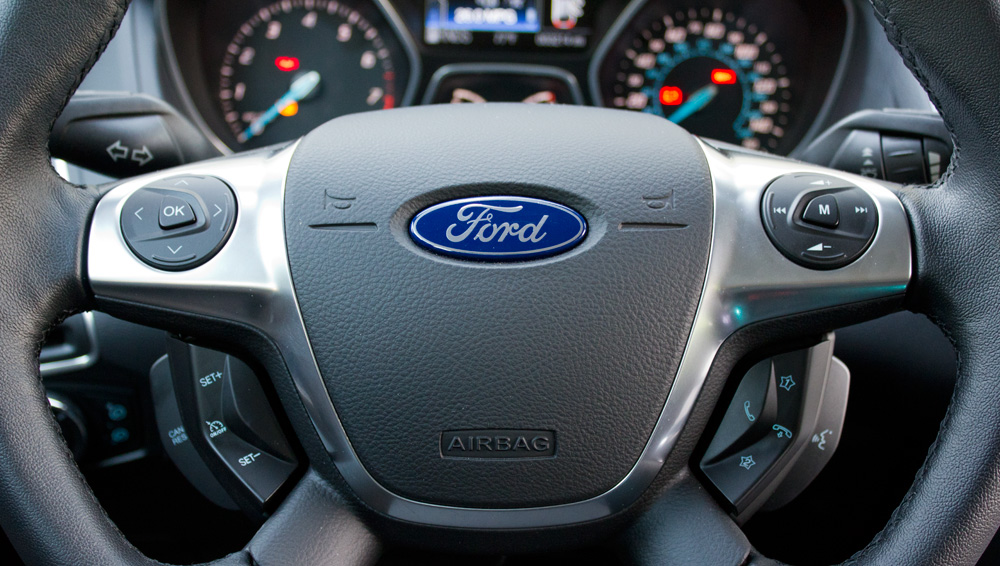
One big chunk of SYNC on Ford vehicles is smart phone integration. It’s a great idea since it keeps eyes on the road and prevents drivers from fiddling around with a device. It is also perfect for those who would rather not wear a headset. Pairing Android, BlackBerry, iOS, and Windows Phone devices via Bluetooth was quite easy with a PIN which appears on-screen. The interface can remember multiple devices though only it can only connect to a single one at a time.
I was quite actually quite excited for the automatic phonebook download feature, but I found it struggling to import the nearly 2,000 entries in my device — though I am probably an exception. With this data readily available in the SYNC system, drivers can simply speak a name rather than having to remember a phone number. In my situation, the voice recognition failed to identify any of the names in my phone book even though I could browse through a full list on-screen — speaking a 10 digit number worked just fine.
I answered a several calls while on the road with a single press thanks to the talk button shortcut on the steering wheel. Unfortunately, the audio quality over Bluetooth was not too pleasant for either party. I often struggled to hear the person on the other end even with the volume turned up and I heard complains from others as well. With that being said, I managed to place a few good calls which leads me to believe that signal strength due to poor coverage was likely a major factor. Regardless, the seamless experience of automatic pairing as you enter the Focus 2012 and having the system transfer a call back to the handset as you exit the vehicle is great.
MyFord Touch also boasts support for transfers of contact images, though the feature did not work with any of the several phones I paired to the car even after manual import attempts. Ford also advertises support for reading out incoming text messages and responding from a selection of pre-defined replies, but this feature only works with a limited number of smart phones.
Instrument Panel Display
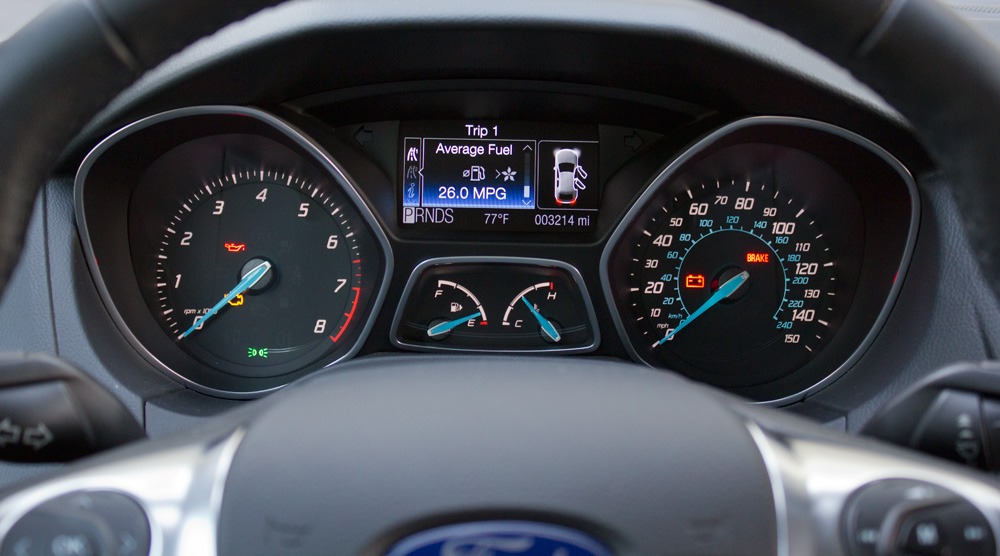
A 4.2 inch LCD display in the center of the instrument panel complements the larger main display centered on the dashboard. This miniature screen provides bits of information such as fuel efficiency, outside temperature, indicators for lighting, the odometer, trip details, distance until an empty tank, vehicle settings, cruise control status, and more.
With the navigator running, the interface dedicates a third of the screen to display directions. This is quite helpful especially when the passenger might be using the main display to mess around with climate controls or find a new radio station. Drivers can interact with the small display by using a five-way directional pad found on the left side of the steering wheel.
Active Park Assist
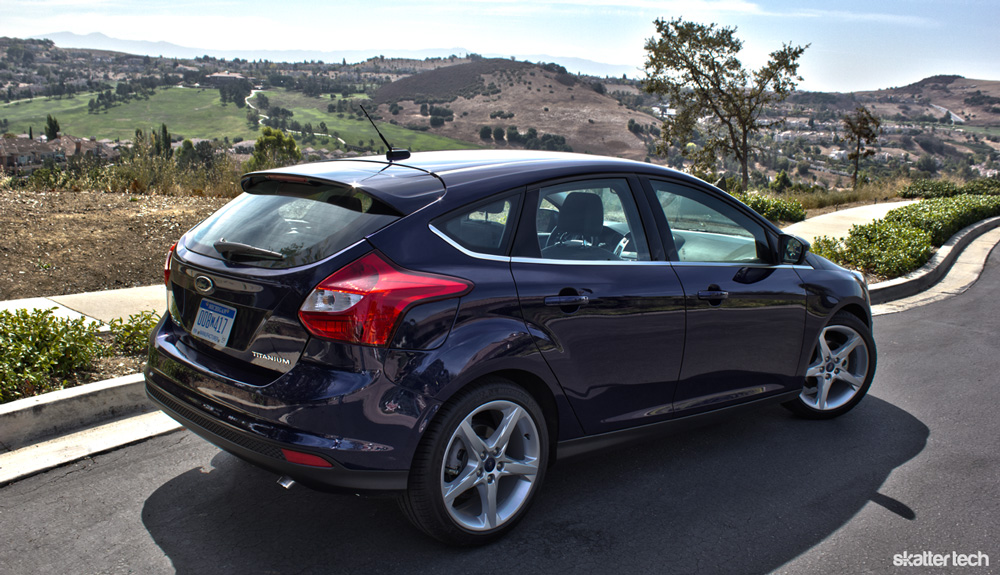
While automatic parallel parking was once a technology reserved for luxury vehicles, Ford makes it available to the masses on the Focus 2012. I have seen the feature advertised for a few years by several manufacturers, but I actually never tried it myself until I Ford handed me the keys to this car. I decided to give the assisted park a shot in a private residential area with nearly no traffic since I did not have high expectations. Ford proved me wrong as the Focus identified an available spot, took control of the wheel, and reversed into the spot on my first try — I only had to keep my foot on the brake to control the speed.
After some added confidence, I decided to try parking on a busy street in Los Gatos downtown. The Focus 2012 backed into an available spot rather quickly which is a major plus since drivers do not have to worry about holding up cars behind them. The self-parking system also does an amazing job of bringing the back and front tires of the Focus within just few inches of the curb every time. I soon put the technology to the test in Berkeley a few days later. While parking is quite easy in areas with plenty of room, I found myself in an extremely tight fit this time around with just a foot or two to spare on a slope. I soon realized that the Active Park Assist can actually perform a multiple-point turn by maneuvering the car back and forth until parked properly.
The backup camera not only provides a line of sight which is much-needed for a hatchback, but also adds visual indicators for distance proximity and draws a trajectory path for easy alignment. The Focus 2012 also has audible feedback with beeps which get louder and faster when getting too close to an object. If I had any suggestions for improvements, it would be to add visual indicators on-screen for the front of the vehicle as well to complement the existing audible alerts.
I also noticed that Active Park Assist only allowed parallel parking on the right side of the street, but I later found owners mention that turning on the left indicator switches modes on an online forum. Ford should consider providing some on-screen guidance to inform users of the option to parallel park on the left side of a street as well as it can come in handy in cities such as San Francisco which have many one-way streets with parking on both sides.
Other In-car Tech
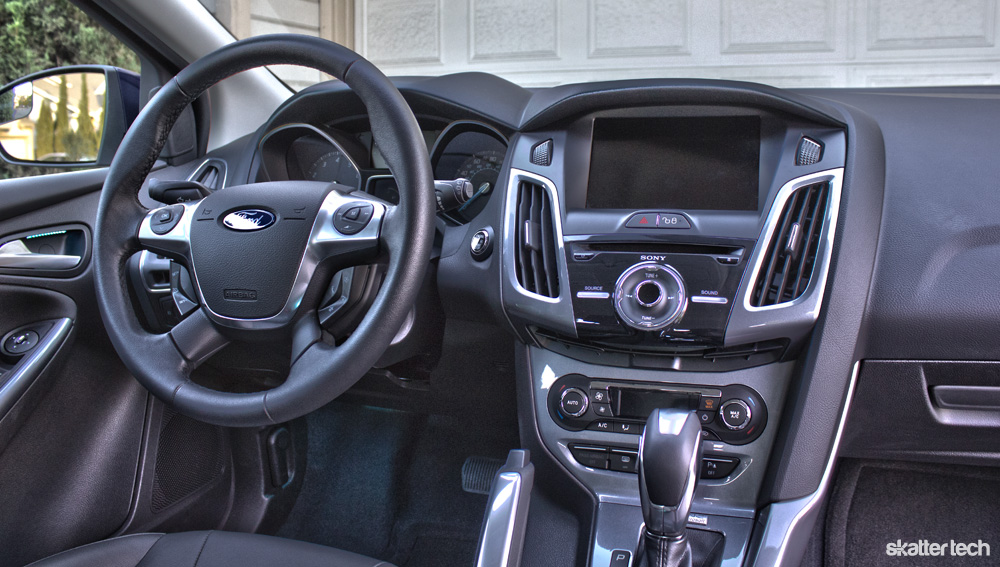
The Focus 2012 comes with plenty of other bits of tech which deserve a mention. For instance, the driver or passengers can control multimedia playback from the steering wheel, the touch screen, or physical controls below the display. While most cars have automatic headlights which turn on when dark, Ford actually has rain-sensing wipers which automatically clear the windshield too.
Though the Focus 2012 has an automatic six-speed transmission, drivers can manually change gears with a touch of a button on models such as the Titanium. There is a built-in universal garage door opener which can replace up to three remote controls. Speaking voice commands such as “cooler” or “decrease temperature” can adjust the climate. My favorite one might just be the ability to say “defrost” when windows begin getting foggy.
New smart phones may now offer built-in mobile hotspots, but Ford also has its own solution. SYNC with MyFord touch lets owners plugin a USB 3G modem to create an in-car hotspot for up to five users. Aside from that, drivers can enter the Focus 2012 without having to reach for their keys thanks to touch sensitive door handles and start the engine with a click of a button.
A Few Bugs
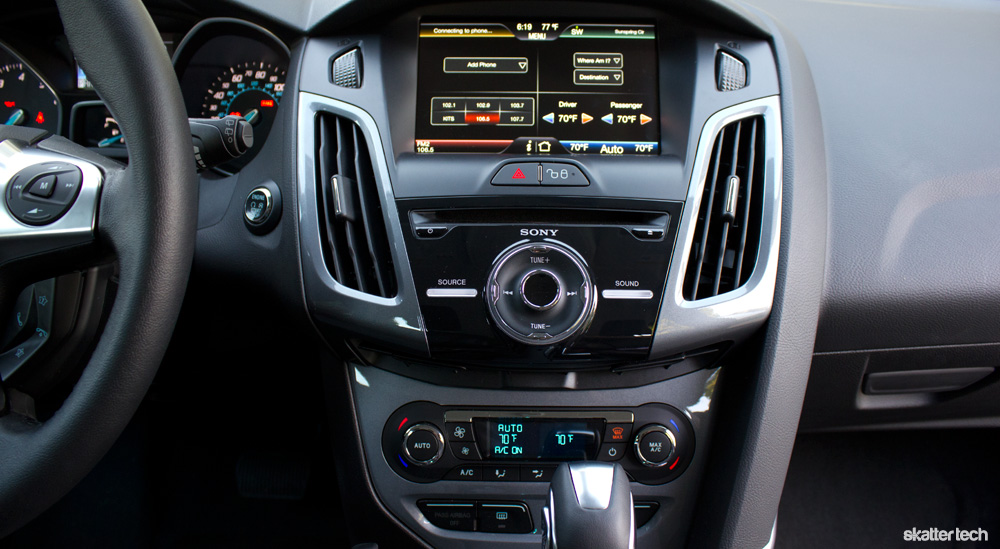
While in-car tech advancements are always exciting, it also creates many opportunities for bugs. I had one particularly bad experience just a few minutes after I began driving the car. The whole SYNC with MyFord Touch system froze leaving me unable to interact with the car using the touch screen or even the controls on the steering wheel. Though the physical controls below the display were still functional, I could not use the touch screen to make calls, get directions, play music, or control the climate. I had to eventually turn off the engine and waited for the entire system to reboot.
I also noticed that the system takes several minutes to perform scheduled system maintenance when starting the car on multiple occasions. I had to wait nearly 5 minutes before I could input an address and another few minutes before the navigator initiated guidance. Considering this happened several times in just a week, I sure hope that Ford resolves this issue in the near future.
The Bottom Line
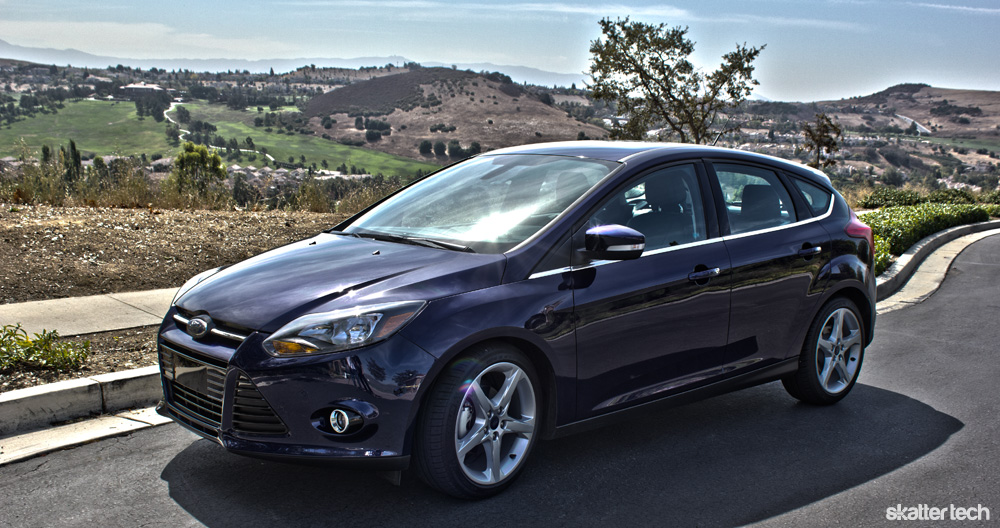
The Ford Focus 2012 definitely offers some of the best consumer-focused in-car tech when lined up against other vehicles of the same class. The company is also working hard to quickly to create an eco-system for third-party applications delivered through smart phones and even hopes to have developers taking on prototyping new concepts with open-source hardware.
While advancements are good news, I strongly feel Ford could improve on user experience. The sheer number of things going on when seated in a Focus 2012 is rather overwhelming even for a computer engineer. Finding simple bits of information such as the time or the temperature often takes more than a single glance due to a cluttered and disorganized interface. there is just too much information on just about any given screen at any time. The ridiculous number of buttons on the steering wheel alone is a bit concerning. Having three sets of controls for a single task is probably unnecessary.
Speeding up the interface which often takes several seconds to react to even simple tasks such as entering digits on a dial pad is a great place to start. Possibly even implementing a Metro-inspired interface for a clean minimalistic distraction-free experience would be a huge improvement. With that being said, Ford still beats many competitors when it comes to being compatible with the technology you already own without having to deal with expensive proprietary add-ons.
I was particularly impressed with the active park assist and I would not be surprised to see Ford eventually begin implementing technologies such as night vision, lane tracking, pre-collision braking, or dynamic cruise control. The 5-door Focus 2012 starts at $18,200 and the Focus 2012 Hatchback Titanium Ford provided Skatter Tech came in a $27,470 configuration. Those looking for a new car packed with technology should definitely consider taking this vehicle out for a test drive.
Links: Ford Focus 2012 | SYNC for MyFord Touch